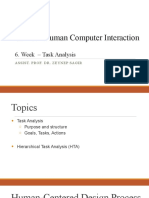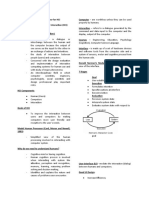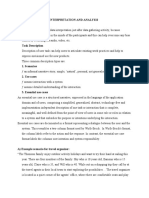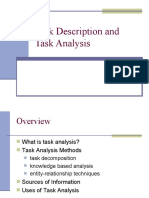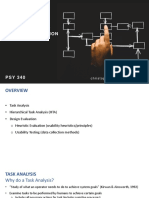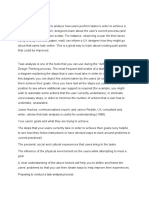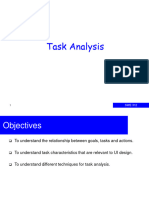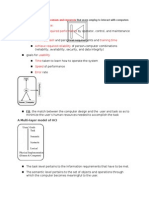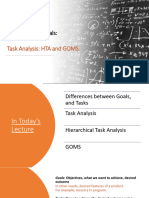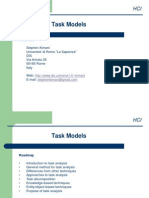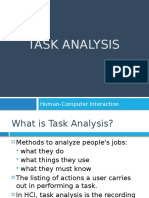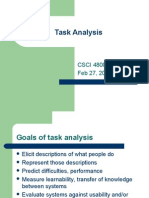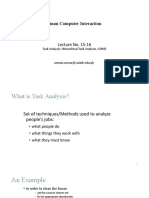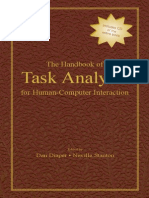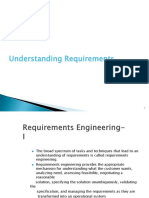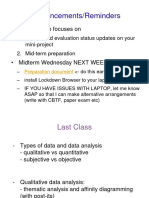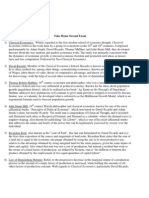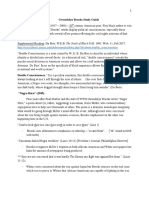Human Computer Interaction
IE403
Dr. Manish Khare
Lecture – 8
�A generalized Cognitive Model
Learnability: Execution side
Visibility & Feedback :
Evaluation side
Efficiency: Measure of whole
cycle, speed of execution and
perception
What I did Vs What just
happened Vs What is it I
am going to
see/experience?
Slide 2
� GoEv Vs GoEx
The Gulf of Execution (GoEx) is
• the difference between the intentions of the users
and what the system allows them to do
• how well the system supports those actions
https://www.educative.io/edpresso/gulf-of-execution-and-gulf-of-evaluation
The Gulf of Evaluation (GoEv) is
• the level of difficulty in assessing the
state of a system
• how well the artifact supports the
discovery and interpretation of that
state
Slide 3
� How designers can bridge the Gulf?
Bridge gulf of execution by:
Signifiers, constraints,
mapping, conceptual model
Bridge gulf of evaluation by:
Feedback, conceptual model
Help users answer these →
questions
7 questions; 7 stages
Slide 4
�ATM Machine –Cognitive & Mental model
Slide 5
� Learnable
I nterface
Smaller GoEx & GoEva
Easier to execute
Slide 6
� Recognition Vs Recall
Recognition:
remembering with the help of a
clue
“using knowledge in or of the
world
Recall:
Remembering with no help
“using knowledge in the
head”
How much do we remember?
Slide 7
� Donald Norman’s model
Seven stages
user establishes the goal
formulates intention
specifies actions at interface
executes action
perceives system state
interprets system state
evaluates system state with respect to goal
Norman’s model concentrates on user’s view of the interface
Slide 8
� execution/evaluation loop
goal
execution evaluation
system
user establishes the goal
formulates intention
specifies actions at interface
executes action
perceives system state
interprets system state
evaluates system state with respect to goal
Slide 9
� execution/evaluation loop
goal
execution evaluation
system
user establishes the goal
formulates intention
specifies actions at interface
executes action
perceives system state
interprets system state
evaluates system state with respect to goal
Slide 10
� execution/evaluation loop
goal
execution evaluation
system
user establishes the goal
formulates intention
specifies actions at interface
executes action
perceives system state
interprets system state
evaluates system state with respect to goal
Slide 11
� execution/evaluation loop
goal
execution evaluation
system
user establishes the goal
formulates intention
specifies actions at interface
executes action
perceives system state
interprets system state
evaluates system state with respect to goal
Slide 12
� The process of design
scenarios
what is task analysis
wanted guidelines
principles
interviews analysis precise
ethnography specification
design
what is there
vs. dialogue implement
what is wanted notations and deploy
evaluation
prototype
heuristics architectures
documentation
help
Slide 13
�Task Analysis
Slide 14
� Recap
Don Norman’s principles
Conceptual Vs Mental Models
Gulf of Evaluation Vs Gulf of Execution
Slide 15
� Norman’s 7 stages of Actions
Questions GOAL EXECUTION EVALUATION
What do I want to
accomplish?
What are my alternatives?
What can I do now?
How do I do it?
What happened?
What does it mean?
Is it OK? Have I
accomplished my goal?
Slide 16
� Making Coffee in a Brewer
Questions GOAL EXECUTION EVALUATION
What do I want to accomplish?
What are my alternatives?
What can I do now?
How do I do it?
What happened?
What does it mean?
Is it OK? Have I accomplished my
goal?
Slide 17
� Task Analysis
How to go wrong doing/asking users to do a task(s)?
Slide 18
�Task Analysis
Task Analysis is the study of the way people perform their jobs.
Aim is to determine:
o what they do
o what things they use
o what they must know
Slide 19
�Example
For example, a person preparing an overhead projector for use would be seen
to carry out the following actions :
1. Plug in to main and switch on supply.
2. Locate on/off switch on projector
3. Discover which way to press the switch
4. Press the switch for power
5. Put on the slide and orientate correctly
6. Align the projector on the screen
7. Focus the slide
Slide 20
�Example
Task: to clean the house
o get the vacuum cleaner out
o fix the appropriate attachments
o clean the rooms
o when the dust bag gets full, empty it
o put the vacuum cleaner and tools away
Must know about:
o vacuum cleaners, their attachments, dust bags,
o cupboards, rooms etc.
Slide 21
� general method
observe
collect unstructured lists of words and actions
organize using notation or diagrams
Slide 22
�Differences from other techniques
Systems analysis vs. Task analysis
system design - focus - the user
Cognitive models vs. Task analysis
internal mental state - focus - external actions
practiced `unit' task - focus - whole job
Slide 23
�What is a Tasks?
«A task is a goal together with some ordered set of actions.»
Goal •A state of the application domain that a work system (user+technology) wishes to achieve
•Specified at particular levels of abstraction
•A structured set of activities required, used, or believed to be necessary by an agent (human,
Task machine) to achieve a goal using a particular technology
•The task is broken down into more and more detailed levels of description until it is defined in terms of
actions
Action
•An action is a task that has no problem solving associated with it and which does not include any
control structure
•Actions are ‘simple tasks’
Slide 24
�What you learn with Task Analysis
What your users’ goals are; what they are trying to achieve
What users actually do to achieve those goals
What experiences (personal, social, and cultural) users bring to the tasks
How users are influenced by their physical environment
How users’ previous knowledge and experience influence:
o How they think about their work
o The workflow they follow to perform their tasks
Slide 25
�Why is it useful?
Task analysis is the process of learning about ordinary users by observing
them in action to understand in detail how they perform their tasks and
achieve their intended goals.
Tasks analysis helps in
o Identifying the tasks that your website and applications must support
o Refining or re-defining your site’s navigation or search
o Website requirements gathering
o Developing your content strategy and site structure
o Wireframing and Prototyping
o Performing usability testing
10
Slide 26
�Example
Tasks are used to plan for the layout
of the application window
Proximity and Boundaries reflect the
decomposition of tasks
Order of tasks is not mandatory
11
Slide 27
� Where it fits
Documentation Observation Interviews
• Extract information
Task Analysis • Sort and classify
• Iterate and refine
Manuals and Requirements ans Detailed interface
Documentation systems design design
• Conceptual Manuals (from KBA) • Focus on system usage rather than • Taxonomies → menu layout
• Procedural (how-to) Manuals (from system features • Objects/actions → interface
HTA) • Suggests candidates for automation objects
• Unconvers user’s conceptual model • Task frequency → default choices
12
Slide 28
�[Some] Techniques for Analysis
Task decomposition − Splitting tasks into sub-tasks and their ordering.
Knowledge-based techniques − Any information and instructions that users
need to know, and how that knowledge is organized
Entity-relationship-based analysis – identify actors, objects, relationships and
their actions
Ethnography − Observation of users’ behavior in the use context.
Protocol analysis − Observation and documentation of actions of the user.
This is achieved by authenticating the user’s thinking. The user is made to
think aloud so that the user’s mental logic can be understood.
13
Slide 29
�Hierarchical Task Analysis
14
Slide 30
�Hierarchical Task Analysis (HTA)
One possible method for Task Decomposition
Hierarchical Task Analysis is the procedure of disintegrating tasks into
subtasks that could be analyzed using the logical sequence for execution. This
would help in achieving the goal in the best possible way.
"A hierarchy is an organization of elements that, according
to prerequisite relationships, describes the path of
experiences a learner must take to achieve any single
behavior that appears higher in the hierarchy. (Seels &
Glasgow, 1990, p. 94)".
15
Slide 31
�Example HTA: How to clean a house
A hierarchy of tasks and sub-tasks
o Indentation and numbering
denote the levels
A set of plans describing in what
order and under what conditions
subtasks are performed
o Plans are labeled by the task they
describe
16
Slide 32
�Notes
Not all tasks are mandatory
o E.g., task 4 is needed only if the
bag is full.
The order or operations may be free
o E.g., the rooms may be cleaned in
any order
Could be further refined with
additional knowledge or context
o E.g.,
Slide 33
�Expanding the hierarchy
Each task is de-composed in sub- Procedural task knowledge
tasks, iteratively and recursively elicitation techniques:
o Answer to the question: «what o Observation, re-enactment
subtasks must be accomplished in o Ask about procedures and
order to perform the main triggers (pre-conditions)
task?» o “What happens if X goes wrong?”
o The answer will come from direct o Sorting steps into appropriate
observation, expert opinion, orders
documentation, …
18
Slide 34
�When is this process stopped?
o Depends on the intended usage
of the HTA (design vs
documentation vs
troubleshooting vs …)
o Expand only relevant tasks
o «Simple» tasks should be obvious
to the users, and they should not
contain hidden risks of failure
o Motor actions are the lowest
level (not always needed)
19
Slide 35
� Example
Plan for the main
goal
Drawing hierarchy
relationships
Plan for a sub-
task
The line says «we stop
decomposition»
20
Slide 36
�Tasks as explanation
Imagine asking the user the question:
o What are you doing now?
For the same action the answer may be:
o typing ctrl-B
o making a word bold o
emphasising a word o
editing a document o
writing a letter
o preparing a legal case
21
Slide 37
�Refining the HTA
Checking matched actions
o Turn “off” without turning “on”?
Restructuring
o “Make pot” might be a meaningful
task and group related actions
Balancing complexity
o Is “pour tea” simpler than “make pot”?
Generalizing
o If we want to make one or more
cups?
22
Slide 38

